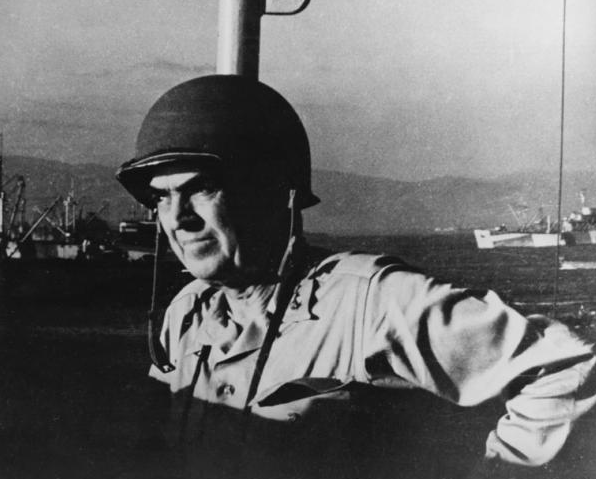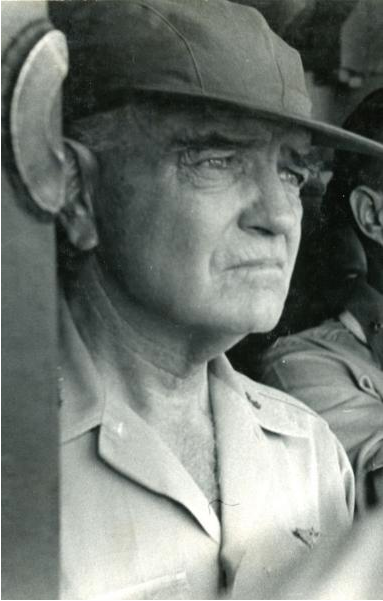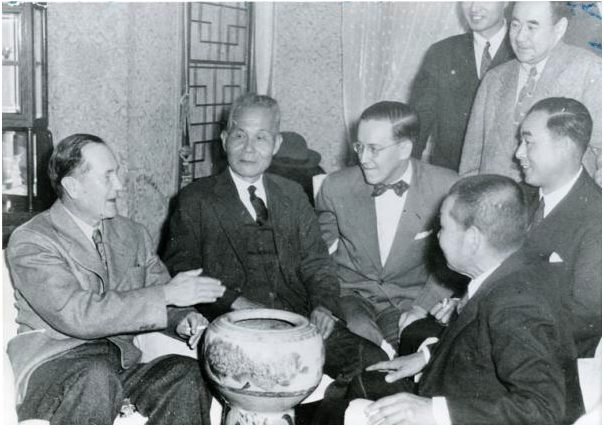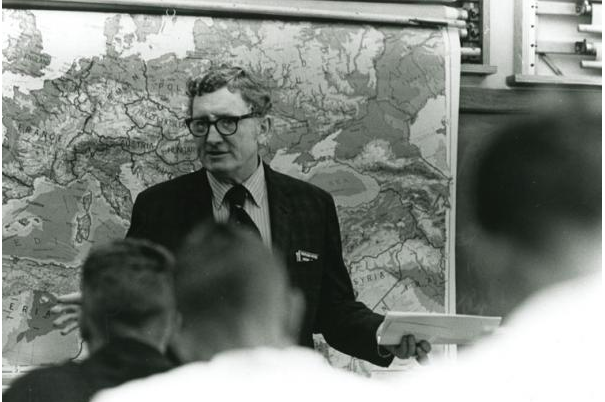Critical reaction to ‘Bull’ Halsey’s performance at the Battle of Leyte Gulf has threatened his stature as the United States’ most admired World War II fighting admiral.

In his 1947 memoir, first serialized in The Saturday Evening Post, Halsey hit back against claims he recklessly had left the Seventh Fleet escort carriers unprotected, resulting in their near destruction. In the self-serving account, Halsey blamed Seventh Fleet commander Admiral Thomas Kinkaid for the carriers’ precarious situation. Kinkaid angrily fired back in a Life magazine article.
It’s your fault!” During a cocktail hour at Pearl Harbor attended by senior officers the evening after the guns fell silent at Leyte Gulf, Lieutenant Commander Chester W. Nimitz Jr. fired that shot across his father’s bow. The younger Nimitz had just learned that Admiral Chester W. Nimitz, Commander-in-Chief of the Pacific Fleet, waited hours before trying to determine what the U.S. Third Fleet’s battleships were doing. Even more stunning was hearing that Admiral William F. “Bull” Halsey, the fleet’s commander, had been given carte blanche to engage the Japanese Navy at the cost of protecting the Leyte invasion forces. Admiral Nimitz abruptly ended the discussion, grumbling, “That’s your opinion.”1
By Heavenly Dispensation
Well aware of the questions his actions must have raised, Halsey tried to get in front of the story. Dashing off a message to Nimitz, he wrote: “As it seemed childish to me to guard statically San Bernardino Strait, I concentrated Task Force 38 [the Third Fleet’s fast carrier force] during the night and steamed north to attack the Northern Force at dawn. I believed that the Center Force had been so heavily damaged in the Sibuyan Sea that it could no longer be considered a serious menace to Seventh Fleet.”2

Nimitz was not ready to accept that explanation, but he also needed to do some explaining. Whatever else happened, Halsey had not violated orders. In his message to Admiral Ernest J. King, Commander-in-Chief of the U.S. Fleet, Nimitz wrote: “[My] regret is that the fast battleships were not left in the vicinity of Samar when Task Force 38 started after the striking force reported to be in the north. . . . It never occurred to me that Halsey, knowing the composition of the ships in the Sibuyan Sea, would leave San Bernardino Strait unguarded, even though the Jap detachments in the Sibuyan Sea had been reported seriously damaged. That Halsey feels that he is in a defensive position is indicated in his dispatch.” Recognizing how much worse things might have gone, Nimitz added, “That the San Bernardino detachment of the Japanese Fleet . . . did not completely destroy all of [the] escort carriers and their accompanying screen is nothing short of special dispensation from the Lord Almighty.”3
Thanks to Halsey’s splendid performance until then, and well aware that he gave Halsey much leeway, Nimitz chose to suppress criticism. Refusing to sign a draft copy of the official report on the battle, Nimitz lashed back at the chief of his analytical section, snapping: “What are you trying to do . . . start another Sampson-Schley controversy? Tone this down.”4 But the facts were too significant to be permanently suppressed, and the controversy that finally erupted would resonate as loudly as the Spanish-American War imbroglio that Nimitz did not want repeated.
Benefiting further from the considerable goodwill he had accumulated, Halsey avoided criticism from the topmost level. Rejecting complaints expressed by his staff, General Douglas MacArthur voiced his full confidence in Halsey. Even volcanic King suppressed his anger. When Halsey said he was wrong in turning his battleships around with the enemy virtually under his guns, King responded, “You’ve got a green light on everything you did.”5

But fortune soon turned against the Third Fleet commander in the form of two typhoons. Most destructive was the first, in December 1944, which claimed three destroyers and hundreds of men and aircraft. A court of inquiry judged that Halsey was primarily to blame, but both Nimitz and King added endorsements that largely nullified the verdict. When his fleet was caught once more by a typhoon in May 1945, Halsey again was found responsible. Nimitz decided that Halsey was guilty of gross stupidity in both typhoons, and only King’s appreciation of his past service and the expected effect on national morale saved Halsey from retirement.
With the coming of peace, the other side of the story of Leyte Gulf became known. Interrogations of the major Japanese commanders included the leader of the Northern Force, Vice Admiral Jisaburo Ozawa, who asserted that his sole mission was to act as a decoy while expecting the complete destruction of his fleet.
War of Words
Awareness that Halsey was duped affected how his actions were subsequently viewed. During 1947, books and book reviews seriously questioned his judgment. In response, Halsey sought vindication through his memoirs, serialized in the Saturday Evening Post before book publication.6
Halsey explained his thinking in pursuing the enemy carriers: “The crippled Central Force’s dogged second approach to San Bernardino, and the weak Southern Force’s simultaneous approach to Surigao against overwhelming strength, were comprehensible only if they were under adamant orders to rendezvous with the carriers . . . for a combined attack on the transports at Leyte.” But the Central Force was far from “crippled,” and Ozawa’s intent was very different. In explaining the grossly incorrect damage estimate for the Center Force, Halsey noted, “The pilots’ reports proved dangerously optimistic, but we had no reason to discredit them at the time.” Surely, Halsey knew how seriously aviators could overestimate results in the heat of battle.

Particularly striking was Halsey’s limited concern about the harm the Center Force might inflict. He wrote: “Even if the Central Force meanwhile penetrated San Bernardino and headed for Leyte Gulf, it could hope only to harry the landing operation. It could not consolidate any advantage, because no transports or supply ships accompanied it. It could merely hit and run.” This is surprising from someone who could recall the devastating Japanese battleship bombardments of U.S. Marines on Guadalcanal and the heavy cruiser threat against the Bougainville beachhead that impelled him to run great risks with his carriers to avert it.
Halsey then unloaded on Seventh Fleet Commander-in-Chief Vice Admiral Thomas C. Kinkaid. Describing how that fleet’s escort carriers were surprised off Samar, he wrote: “I wondered how Kinkaid had let [Rear Admiral Clifton] ‘Ziggy’ Sprague get caught like this, and why Ziggy’s search planes had not given him warning. . . . I figured that the eighteen little carriers had enough planes to protect themselves until [Kinkaid’s battleship commander] could bring up his heavy ships.”
Describing his reaction on receiving Kinkaid’s calls for help, Halsey wrote: “That surprised me. It was not my job to protect the Seventh Fleet. My job was offensive . . . and we were even then rushing to intercept a force which gravely threatened not only Kinkaid and myself, but the whole Pacific strategy.” To Halsey, what happened to the Seventh Fleet was entirely Kinkaid’s fault.
In conclusion, Halsey declared clumsily, “[T]he fact [that the battle] was not coordinated under any authority was an invitation which disaster nearly accepted.” Stated plainly, Halsey believed if he had been given total control, he could have prevented Kinkaid’s and his own problems.
Reading the article, King grasped the dissension it would inevitably create and urged a rewrite of the still-unpublished book. Halsey refused to make any changes.
Provoked into ending his long silence, Kinkaid arranged with a Life magazine writer to tell his side of the story. The article began by asking, rhetorically, “Was . . . Halsey right in dashing off to destroy the Japanese aircraft carriers instead of the battleships—or did he leave a fellow American admiral in the lurch?”7 Vividly, that question was answered in describing Halsey’s attitude on receiving Kinkaid’s plea for help: “There was apparently no thought . . . that Papa Nimitz had told him to protect the kid brother from neighborhood bullies.” And, criticizing Halsey’s inept employment of his own battleships, the article noted, “The American fast battleships spent about half a day steaming north to engage the Japanese force, and half a day steaming south to engage another, but in the end did not fire a shot at either.”8
In May 1952, the U.S. Naval Institute’s Proceedings published an article written by Halsey titled “The Battle for Leyte Gulf,” much of it word-for-word from his book. Gone were many of the criticisms of Kinkaid, replaced by Halsey’s military philosophy that he invoked to justify his decision to keep the fleet intact: “In modern naval warfare there is no greater threat than that offered by an enemy carrier force. To have such a force untouched and to attack it with anything less than overwhelming destructive force would not only violate this proven principle but in this instance would have been foolhardy in the extreme.”9 This ignores the fact that Japanese surface forces posed a greater threat than carrier forces at Leyte Gulf, with enemy carrier power so depleted it could have been overcome with much less than “overwhelming destructive force.”
Morison and Reynolds Weigh In
A year earlier, historian Samuel Eliot Morison had delivered a lecture characterizing the pursuit of the Japanese carriers as “Halsey’s Blunder.” Insisting on conditions that no responsible historian could accept, Halsey wrote to Morison, “To correctly evaluate any decisions . . . it is necessary to consider only the information available . . . at the time such a decision was made.”10 Halsey had good reason for concern, as Morison’s multivolume history of U.S. naval operations in World War II was nearing Leyte Gulf.
When that volume appeared in 1958, Halsey’s fears were fully realized. The book was dedicated to Ziggy Sprague, whose carriers had been imperiled by Halsey’s actions. Paradoxically, since the Japanese were soundly defeated, Morison reserved his highest praise for Ozawa, writing, “He performed his mission of drawing off the major portion of the Pacific Fleet . . . and saved Kurita, as well as his own force, from annihilation.”11
Both Kinkaid and Halsey were faulted for enabling Vice Admiral Takeo Kurita’s descent on the Seventh Fleet. While Kinkaid placed too much confidence in Halsey, Halsey overrelied on his aviator reports, leaving San Bernardino Strait uncovered. A single destroyer posted there could have alerted the escort carriers in time to get beyond Kurita’s gunfire range and prepare for battle.12
Though Kinkaid was roundly criticized, it was Halsey who drew Morison’s heaviest fire. Regarding the decision to concentrate against Ozawa, he wrote, “Halsey ignored the stronger [force] . . . because he mistakenly assumed that it was the weaker, and ‘no serious menace.’” Attacking the validity of Halsey’s assertion that it was essential to keep his forces concentrated, Morison observed: “It was not a case of either-or. Halsey had enough gun and air power to handle both Japanese forces.”13
Morison addressed Halsey’s lost opportunity as follows: “If [the battleships] had been detached a few hours earlier, after Kinkaid’s first urgent request for help, and had left the destroyers [that needed refueling] behind, a powerful battle line of six modern battleships . . . would have arrived off San Bernardino Strait in time to have clashed with Kurita. . . . There is every reason to believe that [Task Force 34 commander Vice Admiral Willis] Lee would have crossed Kurita’s T and completed the destruction of Center Force.”14
Infuriated by Morison’s criticisms, Halsey suggested his former staff members uncover deficiencies in Morison’s writings, “to poke fun at him as a very poor historian and cite some instances to prove our point. In other words, make a laughing stock of him.”15 Halsey wrote to one supporter, “My idea is to get the son-of-a-bitches [sic] cajones in a vise and set up on them.”16 However, Halsey’s former chief of staff, Admiral Robert B. Carney, convinced him to back off, observing that Morison “is firmly established in public opinion as a professional and competent historian. No blast of yours, however justifiable, will destroy that structure; it would far more likely boomerang.”17
Halsey died on 16 August 1959, caught up in controversy over Leyte Gulf during the last dozen years of his life. Thereafter, opinion about his performance in the battle, and indeed his entire legacy, has been left to others who remain fascinated with what may stand as the world’s last great fleet action.
With the appearance in 1968 of Clark G. Reynolds’ forthright study, The Fast Carriers: The Forging of an Air Navy, Halsey’s reputation suffered a devastating blow. Reynolds’ assessment of Halsey’s performance late in the war would fundamentally influence opinion ever after. He wrote, “When Halsey took command [after leaving the South Pacific], he looked upon himself as the fast carrier commander, having little real use for [Vice Admiral Marc A.] Mitscher. . . . This attitude was dangerous, for Halsey lacked the experience of Mitscher.”18
Reynolds observed, “Tactically, Halsey was a meleeist in the tradition of [Vice Admiral Horatio] Nelson. . . . He had daring and was unafraid to take risks, but he was also sloppy in his procedures.”19 The indictment concluded: “Admiral Halsey proved to be an embarrassment to the Pacific Fleet after his arrival in the Central Pacific in mid-1944. . . . Halsey managed to leave the Leyte beachhead uncovered to a Japanese fleet bombardment and then took the carriers into two typhoons. . . . The war simply became too complicated for Halsey.”20
The following year, in Proceedings, U.S. Naval Academy professor E. B. Potter compared the command personalities of Halsey and Fifth Fleet Commander-in-Chief Admiral Raymond A. Spruance. Potter characterized Spruance as a “capabilities man,” whose actions were governed by what the enemy could do. In contrast, Halsey was deemed a “probabilities man,” who acted by considering what the enemy would probably do. Potter also likened Halsey to Nelson, whose unsystematic style led to wild-goose chases but who nevertheless succeeded by being pitted against an incompetent and demoralized enemy. Potter wrote, “It was Halsey’s misfortune to be dealing with a highly motivated, alert enemy.”21
Halsey to Posterity
In the next half century, much has been written about Leyte Gulf, with Thomas J. Cutler’s The Battle of Leyte Gulf particularly useful. Regarding Halsey’s perceived need to keep his fleet intact, Cutler noted how thoroughly Halsey had absorbed Alfred Thayer Mahan’s insistence on concentration of forces as a “first principle.” In Cutler’s view: “There is a tendency for students of warfare to seek ironclad principles and axiomatic rules devised by others. . . . It appears that Halsey was just such a student . . . he appears to have been unable to divest himself of some of the dogmatic baggage that had been part of the Mahanian battleship era.”22
Not only was Halsey’s embrace of Mahan important, Cutler considered it all-important. “Had Halsey divided his forces before going north, had he left part of his tremendous combat capability behind at San Bernardino Strait, instead of taking the entire Third Fleet with him, all of the other errors would be cancelled out.”23 Halsey’s interpretation of his mission, the unclear and misunderstood messages, and all the other problems hardly would have mattered.
Halsey’s legacy, heavily weighted down by Leyte Gulf and the typhoons, remains a subject of debate among historians. Writing at length about those blunders, with minimal consideration of Halsey’s service as South Pacific area commander, Walter R. Borneman ascribes Halsey’s enduring stature as merely reflecting the public’s need for heroes.24 Feeling far differently about the significance of the South Pacific campaign, Eric M. Bergerud considers Halsey’s leadership there sufficient to “rank him among the great admirals of history.”25 Also at the opposite pole from Borneman stands John Wukovits, who rates Halsey as at least the equal of Nimitz as the United States’ top World War II naval commander. Explaining away Leyte Gulf, Wukovits argues, “The mistakes were made by a desire to strike the enemy and were executed with the blessing of Admiral Nimitz, upon whose shoulders much of the blame must rest.” As though such errors might simply cancel each other out, Wukovits wipes Halsey’s slate nearly clean, maintaining, “only with the typhoons can Halsey be charged.”26
Most recently, in his 2016 biography of Halsey, Thomas A. Hughes recognizes Halsey’s “inexplicable mistakes and grand blunders” but appreciates as well his inspired leadership in the South Pacific. Thus, Hughes is in full agreement with Richard B. Frank, who rated Halsey’s performance “outstanding” up to 1944 and “poor” thereafter.27 In line with Cutler’s observations about the influence of Halsey’s early training, Hughes writes, “By 1944, the war had become too large, too modern, and too bureaucratized for his deeply etched patterns of thought and habits of command, learned three decades earlier.” In sum, “[Halsey] was a little bit more, and a little bit less, than a silhouette of his outsized legend.”28
Though the debate will surely continue, almost all can at least agree that if Halsey was not a man for all campaign seasons, he excelled when he was most needed by the nation.
1. E. B. Potter, Nimitz (Annapolis, MD: Naval Institute Press, 1976), 342–43.
2. Ibid., 344.
3. Ibid.
4. Ibid.
5. E. B. Potter, Bull Halsey (Annapolis, MD: Naval Institute Press, 1985), 307.
6. FADM William F. Halsey, USN, wt. LCDR J. Bryan III, USNR, “Admiral Halsey Tells His Story,” (seventh of nine articles) Saturday Evening Post, 26 July 1947, pp. 26, 63–71. The same content appeared in Halsey and Bryan, Admiral Halsey’s Story (New York: McGraw-Hill, 1947), 216–27.
7. Gilbert Cant, “Bull’s Run: Was Halsey Right at Leyte Gulf?” Life, 24 November 1947, 75–90.
8. Ibid, 90.
9. FADM William F. Halsey Jr., USN (Ret), “The Battle for Leyte Gulf,” U.S. Naval Institute Proceedings, vol. 78, no. 5 (May 1952), 494–95.
10. Potter, Halsey, 378.
11. Samuel Eliot Morison, History of United States Naval Operations in World War II, vol. 12, Leyte: June 1944–January 1945 (Boston: Little, Brown and Company, 1958), 336.
12. Ibid., 293.
13. Ibid., 193–94.
14. Ibid., 330.
15. Potter, Halsey, 379.
16. John Wukovits, Admiral ‘Bull’ Halsey: The Life and Wars of the Navy’s Most Controversial Commander (New York: Palgrave MacMillan, 2010), 242.
17. Potter, Halsey, 379.
18. Clark G. Reynolds, The Fast Carriers: The Forging of an Air Navy (Annapolis, MD: Naval Institute Press, 1968), 257.
19. Ibid., 258.
20. Ibid., 387.
21. E. B. Potter, “The Command Personality,” U.S. Naval Institute Proceedings, vol. 95, no. 1 (January 1969), 18–25.
22. Thomas J. Cutler, The Battle of Leyte Gulf: 23–26 October, 1944 (New York: HarperCollins, 1994), 137–38.
23. Ibid., 293.
24. Walter R. Borneman, The Admirals (New York: Little, Brown and Co, 2012), 415.
25. Eric M. Bergerud, Fire in the Sky: The Air War in the South Pacific (Boulder, CO: Westview Press, 2000), 635.
26. Wukovits, Halsey, 246.
27. Richard B. Frank, “Picking Winners?” Naval History, June 2011, 26, 30.
28. Thomas Alexander Hughes, Admiral Bull Halsey: A Naval Life (Cambridge, MA: Harvard University Press, 2016), 418.
Mr. Rems is the author of South Pacific Cauldron: World War II’s Great Forgotten Battlegrounds (Naval Institute Press, 2014). He has been a regular contributor to Naval History since his article titled “Halsey Knows the Straight Story” appeared in the August 2008 issue and earned him selection as the magazine’s Author of the Year.



